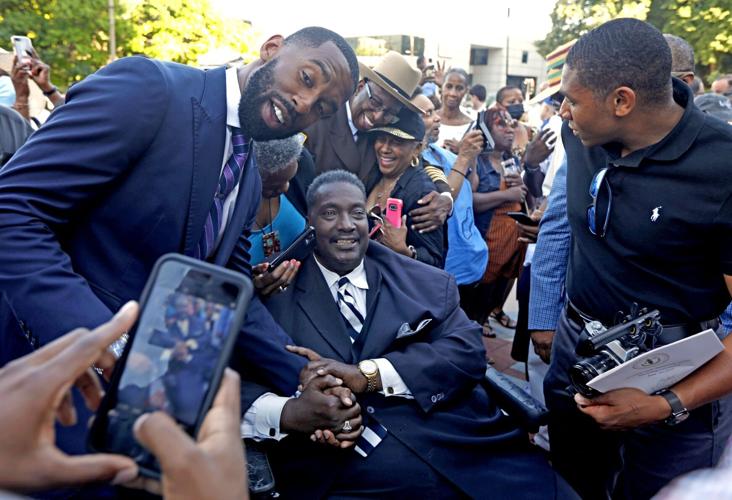ST. LOUIS — Their names are chiseled in stone below the 14-foot bronze sculpture that highlights their legal struggle for freedom.
There’s Mary and Henry. Hetty and Eliza. Charlotte. Vina. Anson and Sam. Most have just one name. They are the former slaves, about 400 of them, who in the early to mid-1800s filed civil lawsuits in ������Ƶ seeking their freedom under the legal theory produced by the Missouri Supreme Court. “Once free, always free,” it said, saying that if a slave had entered free territory, he was entitled to his or her freedom.

Kwame Building Group completed the installation of the Freedom Suits Memorial at the Civil Courts building to honor enslaved plaintiffs who sued for their freedom.
The history of the freedom suits is ignominious and hopeful at the same time. The U.S. Supreme Court, in likely its worst decision ever, overturned freedom for the two most famous names on the memorial — Dred and Harriet Scott — denying their very humanity. The Civil War followed. Then the Emancipation Proclamation. The Thirteenth Amendment. The Fourteenth Amendment. Freedom.
People are also reading…
The march for equality carries on, ever heavy in a country that often likes to forget or whitewash its past. Last summer, the was installed just east of the Civil Courts Building downtown to inspire those entering the city’s courts buildings, making a new generation of history. It doesn’t just memorialize the slaves who fought for their freedom, but the attorneys who filed the lawsuits with no pay, and the judges who went against the grain to grant freedom to men and women who deserved it.
“The design vividly shows how two centuries ago, ������Ƶ provided proof for the American ideal that even those with least means can achieve justice through the courts,” said Circuit Court Judge David Mason, when the sculpture was unveiled.

Supporters swarm the Honorable Judge David Mason in front of the Freedom Suits Memorial sculpture by artist Preston Jackson on Monday, June 20, 2022, at the renamed Freedom Plaza at the Civil Courts Building downtown.
Mason was the driving force behind building the memorial. I first met him a few years ago when the NAACP honored him for his work on the Freedom Suits Memorial. This week, I’ve been camped out in Mason’s courtroom as he considers the freedom of a different Black man — Lamar Johnson — who says the courts didn’t give him a fair shake.
On that matter — whether Johnson’s 1995 murder conviction can stand the test of time — Mason’s already made up his mind on a key element of the case. He said as much from the bench Tuesday, the second day of the hearing, as he told the attorneys seeking Johnson’s freedom that they didn’t need to bother asking questions of an expert witness in eye-witness testimony.
The key eyewitness in the original case — Greg Elking — has recanted his testimony. He now says he has no idea who killed his friend Marcus Boyd, but he was wrong to finger Johnson. Evidence in the case, and not just from Elking, is clear that the photo lineup and in-person lineup that ������Ƶ police and prosecutors relied upon to elicit Elking’s testimony was badly flawed.
The original prosecutor in the case, Dwight Warren, came close to admitting as much on the stand on Tuesday, after Mason asked him why he didn’t have a second lineup, knowing that Elking’s identification of Johnson was suspicious.
“I think that might have been a better practice,” Warren said.
Mason didn’t mince words. “I’ve already reached a fact conclusion” about the eyewitness testimony in the first trial, in which the lineups shown to Elking were clearly over-suggestive. “It’s almost a textbook case,” Mason said.
That may well be enough of a violation of Johnson’s rights to have Mason set aside his original conviction even if he doesn’t find him totally innocent of Boyd’s murder. It took Johnson, who has always maintained his innocence in the case, nearly three decades to get the matter before a judge in a way that could unlock the jailhouse doors and set him free.
It’s exceedingly difficult to win these sorts of cases, in part because the system is so stacked against defendants — especially those without resources. It’s hard to find an attorney who will take a wrongful conviction case, and, perhaps, even harder to get such a case before a judge who has the courage to criticize the mistakes made by police and prosecutors that sometimes lead to wrongful convictions. No matter its best intentions carved into stone in courthouses across the country with Latin phrases describing justice, the judiciary doesn’t like to criticize itself. It took a war to undo the Dred Scott decision.
The Freedom Suits Memorial is dedicated in part to the “lawyers and judges who believed that the courts must be open to all who have a legal claim, regardless of social status.”
Across Market Street from the sculpture, in Mason’s third-floor courtroom, a new generation of lawyers and one judge are putting those words to the test. Lamar Johnson’s fate, his freedom, is in their hands.











